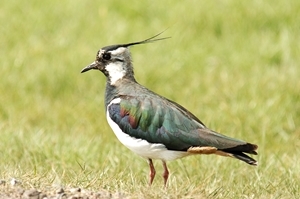Lapwing (Vanellus vanellus)
 One of the most popular birds amongst the farming community (along with the grey partridge and barn owl) is the lapwing. Farmers often relate their delights at seeing tumbling, acrobatic plovers wheezing out their peewit call during the spring months and are also happy to see large winter flocks gathering together, nearly always on the same fields each year, all hunkered down and facing into the strong, chilling northerly breeze.
One of the most popular birds amongst the farming community (along with the grey partridge and barn owl) is the lapwing. Farmers often relate their delights at seeing tumbling, acrobatic plovers wheezing out their peewit call during the spring months and are also happy to see large winter flocks gathering together, nearly always on the same fields each year, all hunkered down and facing into the strong, chilling northerly breeze.
But this love for the peewit – or green plover, as it is also often called – has not always been thus. In fact in days gone by, the lapwing was anything other than popular.
The peewit call of the bird was associated with the legend of the seven whistlers – seven birds flying together by night, whose cries presaged disaster. This call was said to cry “bewitched, bewitched” and so bring evil to those who heard it. The legend was so widely-believed that in 1855 the Leicester Chronicle reported the case of Leicestershire miners who refused to go down the mines, stating that the seven whistlers had been heard overnight and that on two previous occasions when this had been ignored, lives had been lost. But the story that really gave the legend a high profile in folklore history concerned the Hartley colliery in Northumberland. A number of local folk heard the seven whistlers one night in 1862; the very next day the colliery was struck by a huge disaster, and 220 lives were lost.
In Scotland the lapwing also carried a burden of guilt, but for very different reasons. During the seventeenth century, the Scots blamed alarm-calling lapwings for leading the authorities to a meeting of the Covenanters – who regularly met in remote, secret moorland locations, to discuss the defence of Presbyterianism – with nasty consequences.
The Scottish poet John Leyden wrote about the lapwing’s treachery:
The lapwing’s clamorous whoop attends their flight,
Pursues their steps where’er the wanderers go,
Till the shrill scream betrays them to the foe.
I suspect that all these stories accreted over a period of time to give a flock of lapwing its collective name of a deceit.
Luckily these stories are long forgotten and the lapwing is now held in high esteem, perhaps because this once common bird of our farmed countryside has declined so rapidly in recent times. The many reasons behind the decline of this iconic bird follow a similar pattern to other bird species that are specialists of farmland habitats, namely the loss of mixed farming, the general intensification of agriculture and the loss of spring cropping.
We perhaps forget just how common this beautiful bird was in our relatively recent past. In the 18th and 19th centuries lapwings were so numerous that their eggs were collected from Norfolk marshland in their thousands and transported to London markets where they sold as delicacies for three shillings a dozen. It is amazing to think that as recently as 1921, just one man alone collected 1,900 eggs from the Norfolk marches. All this egg collecting was however brought to an abrupt halt (although many farm workers continued to collect a few eggs for their breakfast) with an amendment to the wild birds protection bill on 22 July 1926, when the Lapwing Act was passed.
Occasionally farmers will dispute the fact that the lapwing has declined by a dramatic 50 per cent over the last 30 years, as they see large flocks during the winter months. We must however remember that the winter population can be boosted by up to 2 million birds moving in from the continent, which spend the winter here before returning back across the North Sea in the spring. The current estimate is that we now only have about 150,000 pairs breeding in the UK.
The Game & Wildlife Conservation Trust believe that the declines that lapwing are still suffering at present may have another reason to add to the list already mentioned above – that of predation. A small study in the Avon valley in Hampshire showed that, despite numerous stewardship schemes having been implemented to manage the water meadows, lapwing only managed to fledge the required 0.70 young to maintain a stable breeding population once in five years. The belief is that foxes and corvids may be having a detrimental effect on these nesting lapwing by taking eggs and chicks.
Therefore the GWCT has joined forces with the RSPB to carry out a landscape-scale study across 120 sites in five different counties in lowland Britain that will provide crucial information to help improve government schemes that pay farmers to put in special wildlife measures to help lapwings. An extensive radio-tracking study of young lapwing chicks will be undertaken to identify what is happening to them once they leave the nest. The radio-tracking will provide more detail on chick requirements for food and cover for predator avoidance. The aim is to “provide well-researched solutions, to enable government to tweak its schemes, so that farmers can maximise habitats that help to boost lapwing numbers in the future.”
Perhaps in future the cry of the seven whistlers will be heard less as a harbinger of doom than a hopeful clarion for a resurgent and much-loved bird?
Peter Thompson
Advisory

Download Peter Thompson's essential 26-page book, featuring beautiful photography and detailed profiles of Britain's wildlife
Download FREE >